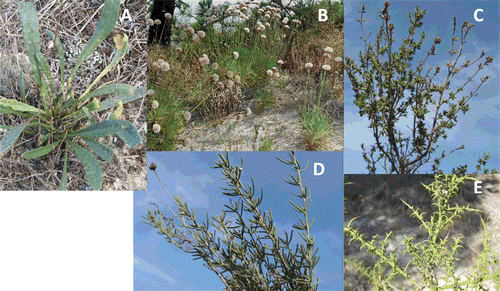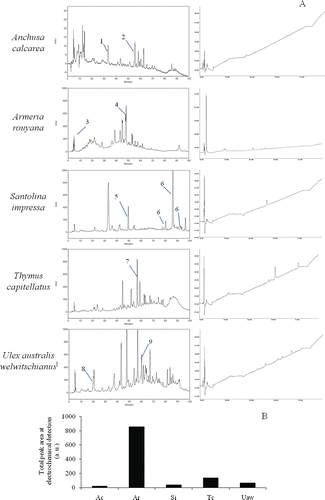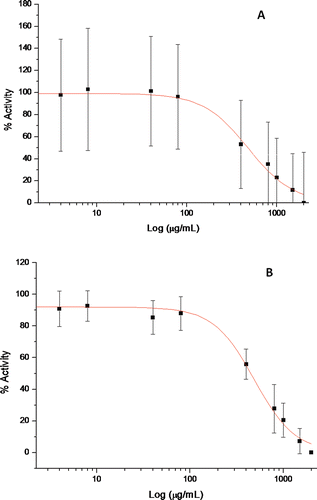Figures & data
Figure 1. Studied plants from the region of Comporta in the Southwest of Portugal in their natural habitat. A- A. calcarea, B- A. rouyana, C- T. capitellatus, D- S. impressa, and E- U. australis welwitschianus.

Table 1. Total phenol content, total flavonoid content and antioxidant capacity (peroxyl radical scavenging and hydroxyl radical scavenging capacities) for the hydroethanolic extracts of the five endemic plants from the Southwest of Portugal under study.
Figure 2. Phytochemical analyses of extracts. A) HPLC chromatograms and respective ED profiles B) total peak electrochemical detection for A. calcarea (Ac), A. rouyana (Ar), S. impressa (Si), T. capitellatus (Tc) and U. australis welwitschianus (Uaw). Tentatively, identifications are signaled in chromatograms. Legend: 1-Chlorogenic or caffeic acid; 2-Myrcetin glucoside; 3-l-Ascorbic acid; 4-Rutin derivative; 5-Ferulic acid; 6-Ferulic acid derivative; 7-Luteolin glucoside; 8-Protocatechuic acid derivative; 9-Apigenin glucoside.

Table 2. Acetylcholinesterase inhibitory activity of hydroethanolic extracts of the five endemic plants from the Southwest of Portugal under study and AChE inhibition is presented as percentage of inhibition using 2 mg mL−1 of extract and for the most effective extracts was calculated the IC50 (μg mL−1). Physostigmine was used as positive control.
Table 3. Acetylcholinesterase inhibitory activity of fractions obtained from SPE fractioning of hydroethanolic extracts of A. rouyana and T. capitellatus. Unbound fraction, that includes sugars and organic acids (including l-ascorbic acid), and Bound fraction, that includes the polyphenols enriched fraction. AChE inhibition is presented as percentage of inhibition using 2 mg mL−1 of fraction.
Figure 3. Nonlinear regression of acetylcholinesterase inhibition profile obtained with Origin Pro 6.1 software (OriginLab©, USA) for plant hydroethanolic extracts. A- A. rouyana, B- T. capitellatus. AChE inhibition was determined based on Ellman’s reaction. Using AChE from electric eel as described in methods. Effect on AChE activity was calculated as an inhibition percentage (%) of the maximum activity (control without inhibitor).

